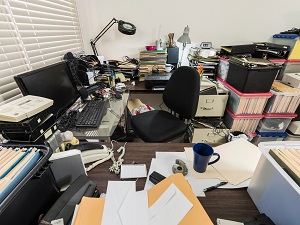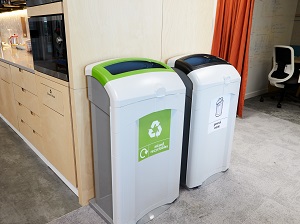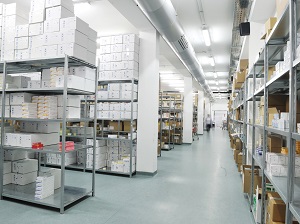Practicing “good housekeeping” is a common phrase used for construction sites and industrial facilities, but good housekeeping practices are also essential in any professional workplace, like corporate buildings, home offices, temporary workstations, cubicles, or traditional office spaces.

Housekeeping isn’t just something that happens after everyone goes home for the evening and the cleaning crew comes in after hours. While employers are required to provide a safe and sanitary place of employment, employees have a responsibility to maintain their work area in a clean and orderly condition.
OSHA Standard 1910.141(a)(3)(i) All places of employment shall be kept clean to the extent that the nature of the work allows.
OSHA can and does issue citations for housekeeping violations because an unsafe work environment can cause injuries to workers directly and indirectly.
Maintaining a clean work environment with good housekeeping can prevent many dangerous situations that can lead to injury including slip, trip and fall hazards, fire hazards, and even health hazards due to insects and vermin.
Clean up after yourself, including after using the restroom or any other common areas. Throw away garbage, wipe down surfaces, and pick up anything that fell on the floor. Wash reusable dishes daily, including coffee cups and utensils, if they are kept at work. Throw away any uneaten food, that is kept in a work fridge, at the end of every week.
Do not keep any food at work that is not in a sealed container. Do not leave any employee-shared snacks out overnight.
OSHA Standard 1910.141(a)(4)(ii) All sweepings, solid or liquid wastes, refuse, and garbage shall be removed in such a manner as to avoid creating a menace to health and as often as necessary or appropriate to maintain the place of employment in a sanitary condition.
Wipe down the microwave after using. Always place a paper towel, paper plate or other cover on the top of any food cooking in a microwave to prevent splatter.

The main reason it’s important to keep your personal workspace clean is to prevent insects and rodents from infesting the workplace. Mice, rats, roaches, ants and other pests are considered a health hazard risk in an office environment.
Dispose of trash that may have accumulated at the end of the workday, including food wrappers, used paper towels or tissues, beverage containers, etc. If personal trash cans aren’t emptied at the end of every day, dispose of all food and drink trash in the breakroom trash can, or other trash can that is emptied nightly.
Do not throw drink cups into the office trash if they still have liquid in them. Trash bags often leak which will cause a sticky situation in the bottom of the trash can that may be inviting to ants.
Do not store food packages that have been opened inside of desk drawers or cubicle cabinets. Keep all food stored in airtight plastic containers.
Don’t eat messy meals at your desk. If you do consume food at your desk, do not eat over your keyboard where crumbs can be left behind, and wipe up thoroughly after the meal. Maintain a tidy work area so that food wrappers and drink cups aren’t overlooked, and your workspace doesn’t become a shelter for unwelcome pests.
If you notice ants, vermin, or droppings in any work or common area, notify management immediately.

Stairs, hallways, exit routes and emergency exits must all be kept clean and free of trash, debris, and any slip and trip hazards. Report or clean up spills or trash found on the stairs.
Never use stairways or landings as a storage place for office supplies, even temporarily. Exit signs must be clearly visible and emergency exits must not be blocked.
OSHA Standard 1910.37(a)(3) Exit routes must be free and unobstructed. No materials or equipment may be placed, either permanently or temporarily, within the exit route.
Designated employee walking areas must be free of slip, trip and fall hazards. Electrical cables and extension cords can easily become trip and fall hazards if not routed carefully. Keep all cords close to a wall and away from foot traffic to prevent tripping and cord damage.
OSHA Standard 1910.22(a)(1) All places of employment, passageways, storerooms, service rooms, and walking-working surfaces are kept in a clean, orderly, and sanitary condition.

The high volume of electrical equipment in a typical office can expose workers to serious electrical hazards, including shocks, burns and fire.
Overloaded power strips and wall outlets are the most common electrical hazards in any office. Electrical circuits that are overloaded pose both an electrocution hazard and a fire hazard. Overusing an outlet can lead to overheating or a power shortage. Damaged wires and cables can cause electric shocks and present a fire hazard.
Avoid overloading wall outlets. Do not plug in too many items that require power at once. Never run power cords under rugs or where chairs can roll over them. Do not run electrical cords through high-traffic areas, under carpets, across doorways or through windows.
Do not secure any power cables to surfaces with staples or nails. Place power strips where there is plenty of air circulation to disperse heat. Regularly inspect electrical cables to ensure they are not frayed, cracked or otherwise damaged.


.jpeg)
